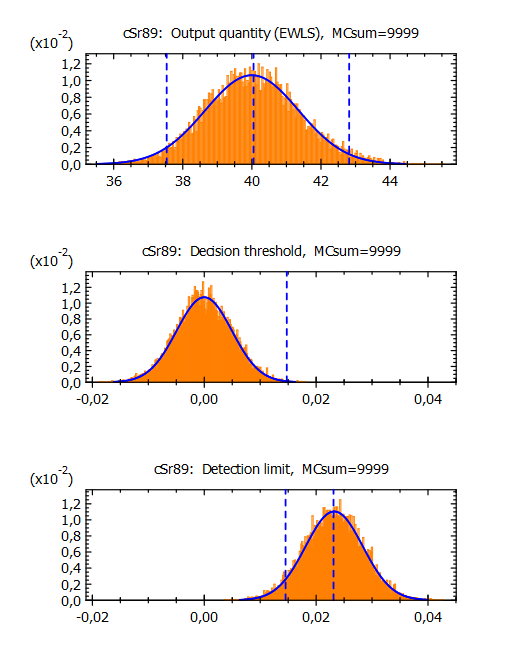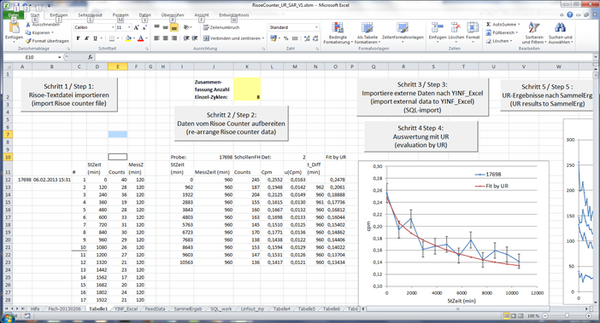Software for calculation of characteristic threshold values accordung to ISO 11929 for radioactivity measurements - UncertRadio
The software **UncertRadio** enables the automated calculation of characteristic threshold values of activity mesurements according to ISO 11929.
These include the activity concentration or specific activity and its combined
standard measurement uncertainty, an uncertainty budget and values of
decision threshold and the detection limit.
The uncertainties of the single output values are calculated using
numerical error propagation according to ISO GUM.
UncertRadio can be used for a variety of applications from Alpha, Beta and Gamma measurements, but also from dosimetry. It has the capability to derive the characteristic values for up to three radionuclides simultaneously, whose output quantity values, e.g. activity values, of which are dependent from each other due to the measurement. Therefore, it is especially suited for modern liquid scintillation measurement procedures of e.g. Strontium isotopes.
There are two main analytical approaches used within the software:
- procedures without linear unfolding: the basic evaluation model is linear in
the net count rate; numerically applied propagation of uncertainty
values of input quantities (Kanisch, 2016a),
- procedures with linear unfolding: linear Least squares procedures e.g. for decay or build-up curves(Kanisch, 2016b).
Alternatively, an evaluation by Monte Carlo simulation may be used within both approaches. This represents the method of propagating whole distributions and is in advantage in the case of significant deviations from the normal distribution; see ISO GUM Supplements 1 and 2.
Applying UncertRadio means that the user should be able to formulate the equations used for the calculating values of the output quantity. A special advantage is, however, that no partial derivatives are to be supplied. For a better understanding of the course of the software and of user-supplied equations and functions an extensive bundle of application examples as project files is included into the installation.
Many of the application examples are from the working group "AK-SIGMA" of the “German-Suisse Association for Radiation Protection”, from Measuring Instructions of the German Co-ordinating Offices and from the literature. These examples including those of a German National Supplement 1 of DIN ISO 11929 (2014) contributed to the validation of UncertRadio.
The author is grateful for the feedback and new requirements of the user-community, especially from federal coordination centres and the laboratiories of the German Federal States working after AVV-IMIS on monitoring of environmental radioavitiy, and significantly improved the quality and usability of UncertRadio.
Since version 2.5.1, the source code is available online and UncertRadio can be created from the sources. The associated installation guide is given below. Pre-compiled packages are still provided for Windows. These consist of a packed archive containing all required files. After unpacking, the program can be started with the "UncertRatio.exe" found within the "bin/" subdirectory.
Version 2.4.32 is the last version that can be installed with an installation program for Windows.
From version 2.1.4 (2017) to 2.4.32 the download consisted of one executable file, which combines all required components of teh Software (help-files, short installation guide, collection of validated example projects). Additionally, a brief instruction to use the software was provided for download. The private or commercial use of the software is free of charge.
Since version 1.08 (2013) **UncertRadio** can be used as an interface between the software for acquiring measurement data and the transfer of characteristic values into a modern laboratory information system. The csv format is used for data import and export.
The program’s author is Günter Kanisch. Contact person for questions and suggestions is Dr. Marc-Oliver Aust from the “Federal co-ordinating Office for fish and fishery products, crustaceans, mollusks and marine algae” in the Thünen- Institute of Fisheries Ecology (contact: see left panel)
Important note:
UncertRadio is free software: you can redistribute it and/or modify
it under the terms of the GNU General Public License as published by
the Free Software Foundation, either version 3 of the License, or
(at your option) any later version.
UncertRadio is distributed in the hope that it will be useful,
but WITHOUT ANY WARRANTY; without even the implied warranty of
MERCHANTABILITY or FITNESS FOR A PARTICULAR PURPOSE. See the
GNU General Public License for more details.
You should have received a copy of the GNU General Public License
along with UncertRadio. If not, see <http://www.gnu.org/licenses/>.
The software was developed by the author following state-of-the-art of science, standardization and technology and validated with respect to the correct mathematical treatment of the model input equations of the evaluation model. Nevertheless, no warranty is given for the correctness of results obtained by the user working with UncertRadio, neither by the author nor by TI and BMUKN, and no responsibility is taken for emerging demands by any third party.
Literature
If you are using UncertRadio, please consider citing the following papers:
KANISCH, G.; OBER, F.; Aust, M.O.: UncertRadio: Software for determining characteristic threshold values in accordance to ISO 11929 for environmental radioactivity measurements Journal of Open Source Software (JOSS), submitted for publication
KANISCH, G.: Generalized evaluation of environmental radioactivity measurements with UncertRadio. Part I: Methods without linear unfolding.
Appl. Radiat. Isot. 110, 2016, 28–41
dx.doi.org/10.1016/j.apradiso.2015.12.003
KANISCH, G.: Generalized evaluation of environmental radioactivity measurements with UncertRadio. Part II: Methods with linear unfolding.
Appl. Radiat. Isot. 110, 2016, 74–86
dx.doi.org/10.1016/j.apradiso.2015.12.046

![[Translate to English:] [Translate to English:]](/media/_processed_/2/9/csm_Embryo-Exp_Gelege_9F_dpf5-200513111619_c8534a8199.jpg)
![[Translate to English:] [Translate to English:]](/media/_processed_/2/9/csm_Embryo-Exp_Gelege_9F_dpf5-200513111619_9027994d44.jpg)







